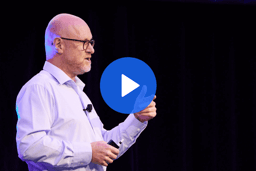[CONTINUED]
Rationalize applications in 6 steps

6 steps to rationalize applications. Source: A Guide to Application Rationalization
For a successful app rationalization initiative, there are 6 main steps required to complete.
1. Set application rationalization scope
Develop a strategy involving multiple iterative projects for a focused scope. Each concentrated rationalization effort should only focus on applications that support specific business capabilities or organizational units - of course, always considering strategic business goals. Rationalizing all applications at once has shown that its likelihood of success is low.
When deciding on the scope of your application rationalization efforts, it is beneficial to consider your operating model. There are 4 operating models based on the degree of process standardization and process integration:
- Diversified operating model: Independent business units with different business models (e.g., GE). Optimize processes and applications within each business unit individually.
- Coordinated operating model: Unique business units with strongly coordinated transactions (e.g., Merrill Lynch). Rationalize information assets with the objective of establishing a single source of truth.
- Unified operating model: single business with global process standards (e.g., Delta Air Lines). Perform broad-scope application rationalization that enables enterprise systems to enforce the standards and maximum possible improvements.
- Replicated operating model: Independent but very similar business units (e.g., Marriott). Establish standard infrastructure and application components for global efficiencies one business unit at a time.
During the scoping phase, it is imperative to involve business and IT leaders in the planning process to prioritize, delegate, and support ongoing rationalization projects. With the added help of other business points of view, the full picture will always be aligned.
2. Build your inventory
An application inventory is a list of all the software applications that are currently deployed in an organization. It includes information about applications' functionality, business relevance, owners, and other relevant details.
There are two ways to build an application inventory. The one you will use depends on the size of your organization.
- Use spreadsheets: Quick but manual effort for smaller organizations without a large number of applications and a non-complicated organizational structure.
- Use professional tools: To continuously monitor the IT landscape, use enterprise architecture or application portfolio management tools, such as LeanIX EAM or LeanIX SMP. Professional tools are best for mid-size companies and enterprises with a complex organizational structure, hundreds of applications, or multiple departments.
A comprehensive application inventory provides valuable insights into an organization's application landscape. The success of app rationalization relies on the completeness of the data collected.
📚 Related: How to build an Application Inventory? and Create an Application Rationalization Questionnaire
3. Assess the application portfolio
The assessment step can range from simple to advanced depending on the organization's maturity level and needs.
- A simple model (pragmatic approach): A model which is used within LeanIX EAM's core reports. It is collected collaboratively with all application owners using custom surveys. Each application includes information about functionality, technicality, strategic value, costs, and data-related aspects. These criteria can be used to evaluate applications and make decisions about their usage, decommissioning, or replacement.
- Advanced model to assess applications by functionality (Beyer- Smertnig model): Assess applications' functional suitability based on support and criticality. The criticality assessment ranges from -2 (not relevant to success) to 2 (critical to success), with 0 representing an obligatory functionality. The support assessment ranges from -2 (not supported) to 2 (excellently implemented with no need for change), with 0 representing standard support. Intermediate values of 1 and -1 can also be used to reflect more nuanced evaluations.
After this step, you will be able to display your application portfolio in matrix and landscape views. These views will give you valuable information about the health of your portfolio and help you identify areas where rationalization is needed.
📚 Related: How to Assess your Application Inventory?, Assess the Criticality of Applications, What are Mission-critical Applications?, and What are Business-critical Applications?
4. Define the target state
At the end of this step, you will be able to make a decision on every application. There are multiple methodologies with which you can define the future state of your landscape. The two most known ones are the TIME model or 6Rs. No matter which one you choose, both support these four general outcomes:
- Keep: Keep the application and consider further investing in it (high-value application in good technical shape). Tolerate the application as it is doing its job (a certain amount of value in good technical shape) or if there is no reasonable alternative.
- Update: Modernize applications as they are of high value to the business (high-value application supported by aging technology)
- Migrate: Retire application, migrate data and users to an existing application (redundant applications), Standardize multiple applications on a common version/ technology platform, Merge applications (either physically, logically, or both), Replace the application with a commercial off-the-shelf solution.
- Eliminate: Retire low-value applications without replacement (e.g., not used, low value, based on aging technology).
Or, try using this application rationalization decision tree.
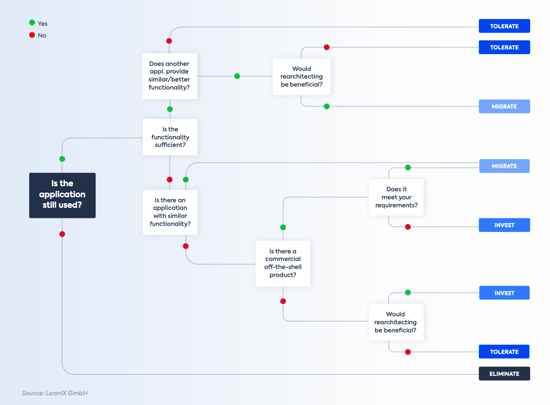
Application rationalization decision tree. Source: A Guide to Application Rationalization
5. Plan the implementation roadmap
The application rationalization process will be done in waves - immediate, mid-term, and long-term, focusing on elimination, migrations and consolidations, and full rewrites or upgrades.
It is crucial to involve business leaders, IT leaders, and enterprise architects to review recommendations and create a best-fit roadmap for implementation.
This will establish transparency and align the business with IT. At the end of this mapping phase, defined architecture standards and structures for future analysis should be in place.
📚 Related: Define your Target Architecture and Create you Application Modernization Roadmap
6. Make it an ongoing process
Now that the portfolio is officially optimized, it is imperative to continually maintain the landscape. Onetime application rationalization endeavors might save the organization money in the beginning, but they lack the long-term value that continual application rationalization offers.
Application rationalization improves the overall effectiveness of IT and ensures that the IT landscape is actively aligning with business goals and objectives. The continual revisitation of the application portfolio is just as important as the previous steps.
📚 Related: Application Rationalization in LeanIX

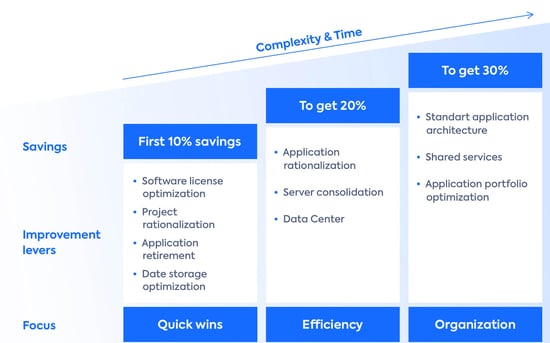
/EN-Poster-Save_IT_Costs_Framework-Poster_Resource_Page_Thumbnail.png?width=260&height=171&name=EN-Poster-Save_IT_Costs_Framework-Poster_Resource_Page_Thumbnail.png)
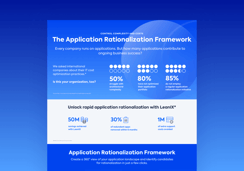

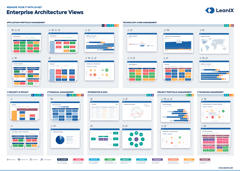

/EN/White-Paper/EN-IDC-Inforbrief-Application-Rationalization-Portfolio-Management-Thumbnail_v2.png?width=260&height=171&name=EN-IDC-Inforbrief-Application-Rationalization-Portfolio-Management-Thumbnail_v2.png)

/EN-WP-IT_Cost_Savings-Resource_Page_Thumbnail.png?width=260&height=171&name=EN-WP-IT_Cost_Savings-Resource_Page_Thumbnail.png)
/Guide_BC_WhitePaper_Resource_Page_Thumbnail.png?width=260&height=171&name=Guide_BC_WhitePaper_Resource_Page_Thumbnail.png)




